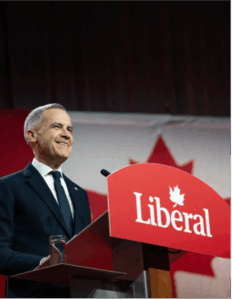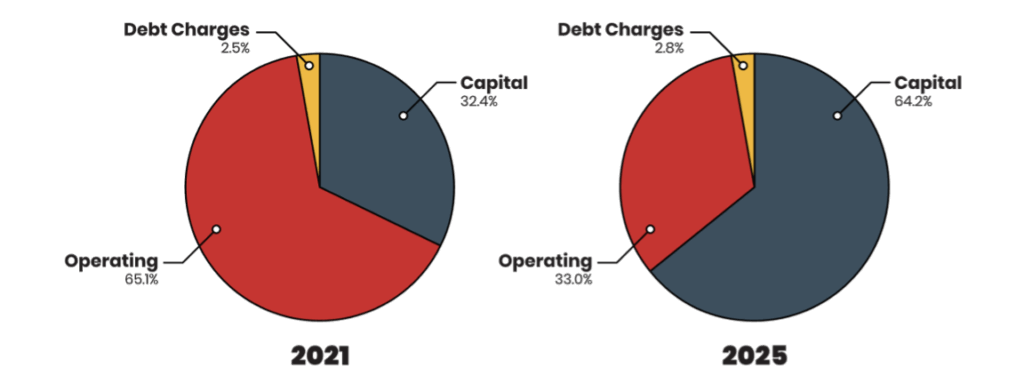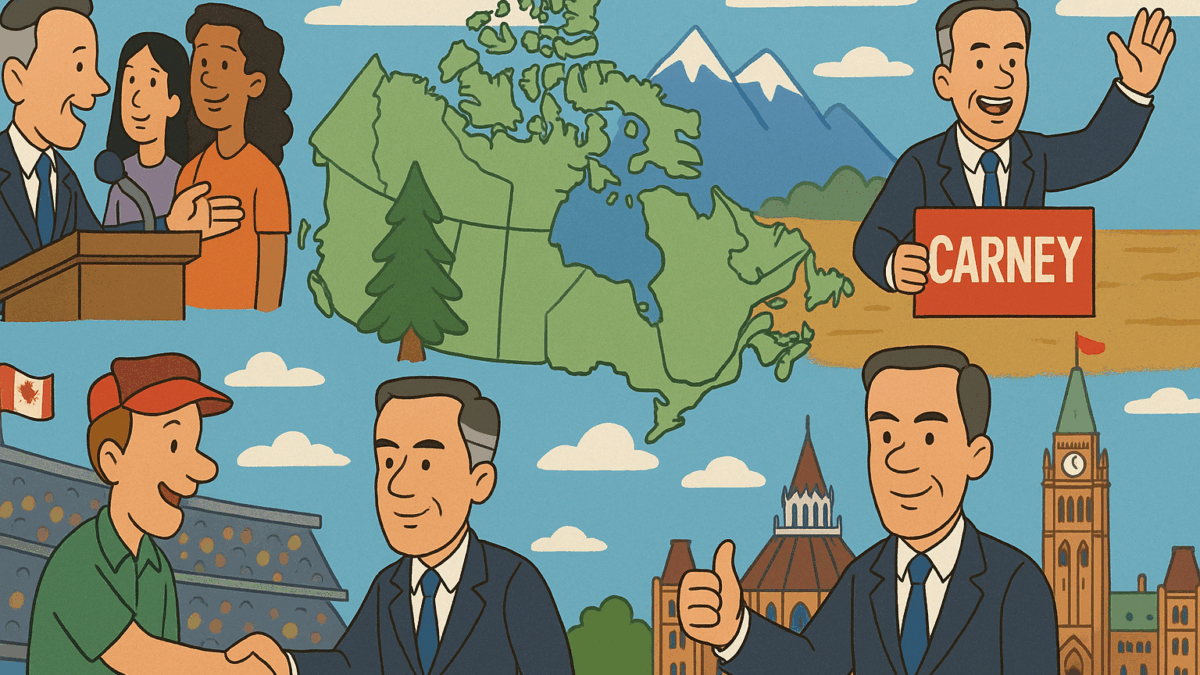
The Liberals released their full election platform on April 19th, the first of the two major parties to do so. It’s called Canada Strong. The subtitle is “Mark Carney’s Plan: Unite. Secure. Protect. Build”. You can read the full document here.
It contains 287 specific initiatives and another 50-plus sub-initiatives within its 55 pages. These are grouped around the four main themes of Unite, Secure, Protect, and Build. It also contains an eight-page Fiscal and Costing Plan.
The platform has real implications for federal public servants and how a re-elected Liberal government proposes to operate. Let’s review.
More Government
The platform proposes to create five new government agencies. These are:
- Major Federal Project Office to accelerate review of projects such as energy and trade infrastructure
- Defence Procurement Agency to centralize expertise and streamline the purchasing of military equipment
- Bureau of Research, Engineering and Advanced Leadership in Science (BOREALIS) to provide made-in-Canada innovation solutions for AI, quantum computing, and cyber security for the Canadian Armed Forces and the Communications Security Establishment
- Build Canada Homes (BCH) to get the federal government back into the business of building homes
- Office of Digital Transformation at the centre of government to proactively identify, implement, and scale technology solutions and eliminate duplicative and redundant red tape, and centralize innovative procurement.
Currently, there are federal departments and agencies already performing these roles. The aim is to have a more focused approach by creating these new agencies around specific mandates. This may then require some consolidation such as folding the Major Project Management Office which is tasked to provide overarching project management and accountability for major resource projects in the federal regulatory review process, into the new Major Federal Project Office. Defence procurement is currently carried out by Public Services and Procurement Canada, although this was changed in the new Carney cabinet to Government Transformation, Public Services, and Procurement. Build Canada Homes will have to sort out its mission and mandate from CMHC and the Department of Housing, Infrastructure, and Communities. The Office of Digital Transformation is clearly a response to a recent strategy on AI released by the government in March. It called for AI Centre of Expertise for the Government of Canada. BOREALIS appears totally new.
Effective Government
The Liberal platform speaks directly to not just what the government should be doing, but how it should be doing it. This is how they introduce the section called “Building Responsibly”:
“The federal government has been spending too much. There are federal programs and processes that aren’t working as well as they should and adjustments that need to be made if we are to respond with strength to this challenging moment. Efficiency and effectiveness must guide everything government does. Change means adjusting how we do things, to make the best use of our talented public service and new technologies, to save money. It means focusing on outcomes for Canadians and making sure they get what they expect from their government.”
While this section is mostly focused on making government more effective in supporting investment that “builds the economy”, it recognizes that government itself must improve the way it delivers on this support. “Spend less, invest more” is the fiscal management approach it offers, by committing to “balancing the operating budget by Budget 2028”. New spending would be “investment” in the military, infrastructure, and other capital formation priorities principally. To support this, the platform states:
“More than half of incremental expenditure over the next four years will be capital related, driving significant growth in our housing stock, defence equipment, and the private sector capital base.”
Transforming Government
The Liberal platform provides a Fiscal and Costing Plan to show how they will pay for their promises. Central to this will be the application of a new accounting principle which separates capital and operating spending. The goal is two-fold: first, allow for a clearer focus on capital investment spending that they say is needed to grow the economy; second, allow for a gradual but specific decline in total operating expenditures so they align with revenues, closing an estimated $15 billion annual gap between the two. The total deficit would decline, the platform states, “as a share of GDP … and all net government spending by the fourth year will be capital related.”
The platform sets it out this way:
“As a result of the main investments and savings proposed in this plan, direct program expenses are projected to grow at an average rate of less than 2 per cent per year through 2028-29. This compares to a compound annual growth of nearly 9 percent over the previous decade.”
Comparing Liberal Platform Spending

To achieve these goals, the platform spells out several government transformation measures, consistent with the new styling of the Department of Government Transformation, Public Services, and Procurement. Most significantly is the announcement that a Carney government would “…launch a comprehensive review of government spending in order to increase the federal government’s productivity.” The review would focus on the following:
- Amalgamating service delivery so there is one point of access for Canadians in how they interact with government programs
- Consolidating grants and contributions that serve similar purposes and are delivered to the same organizations across multiple departments
- Better leveraging technology to improve the automation of routine tasks and inquiries from the public and reducing the need for additional hiring (AI)
- Significantly reducing reliance on external consultants, while improving the capacity of the public service to hire expertise in-house
- Better managing litigation and contingent liabilities and improving asset management practices.
An unspecified portion of savings would “be redeployed to invest in technology and people” for service quality improvements.
Once this review is conducted, a permanent review process will be instituted at the departmental level “to link spending and outcomes” in a continuous process.
Smaller Government
The rapid and sustained rise of the federal public service gets attention in the Liberal platform. However, there is no commitment to cutting the size of the public service; rather, it will be “capped” at an indeterminate level. The platform states that there remains a need for federal workers to help “Canada meet this moment of crisis” (Trump tariffs and global economic disruption). No targets or goals or timelines are noted for this capping, but it will have to fit into the overall reduction in operational expenditures noted earlier.
At the same time, many of the initiatives will require more public servants unless digital technology and AI are deployed as alternatives, something which is explicitly mentioned. Two examples of this can be found in the immigration section. There is a commitment to “strengthen the integrity of the border by increasing resources for security screenings” as well as “work towards a fairer and faster process and enhance service delivery for applicants by leveraging digital service tools to reduce processing times and eliminate backlogs”.
Assessment
From a public service and government operations perspective, the Liberal platform offers a continuation of an activist federal government Canadians have seen for the past decade. There are a lot of new initiatives.
The need to ‘Trump proof’ the economy is top of mind with initiatives aimed at economic growth through catalyzing private sector capital investment. The expectation is that it will catalyze some $500 billion in new investment over the next five years.
A key other focus of new government spending will be the Canadian Armed Forces, as the platform states:
“The single largest individual investment in this plan relates to rebuilding, rearming, and reinvesting in the Canadian Armed Forces. More than $30.9 billion will be added to defence-related spending through this plan over the next four years, on a cash basis.”
The size of government will be squeezed but perhaps not unduly strained by this platform. It has been many years in official Ottawa since a true program and service review has been conducted. The last one was during the mid-years of the Harper government.
The most extensive one was the 1994-96 review under the Chretien government. It reduced expenditures by a cumulative $27.2 billion between 1994–95 and 1998–99, eventually balancing the budget for the first time since the 1950s. It is unlikely that level of savings would be achieved in a Carney government effort as the platform explicitly removes transfers to governments and individuals from any reductions, which was not the case under Chretien.
Improved productivity within government is recognized within the platform. There are several references to the increased application of digital technologies and AI to improve service delivery. This echoes the government’s own recently released AI strategy but that illustrated the need for more investment, skills development, and internal coordination to accomplish. The platform recognizes this. A yet-to-be-released report by Treasury Board’s Working Group on Public Service Productivity might provide more suggestions on how this is all to be accomplished.

